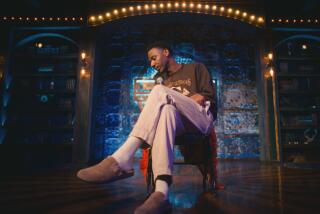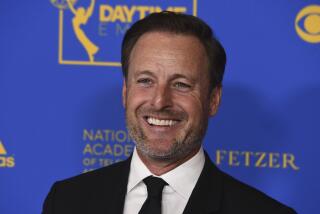For gays, reality TV can be a path to acceptance
“Redneck Island” hardly sounds like a welcoming place for a gay man. But Adam Freeman, a Nashville hairstylist who came out of the closet four years ago, shipped out to CMT’s reality show this year for several weeks, finishing unscathed and in second place.
A niche version of CBS’ long-running mega-hit “Survivor,” the program featured hunting, bowling and fishing events in which Freeman competed against proudly beer-chuggin’ good ol’ boys and country gals. The father of five was open about his sexual orientation and says his only regret was not packing “enough lip gloss and hair spray.”
PHOTOS: Gay Celebrities - who’s out?
“Some [cast members] that were from smaller areas and had not had the opportunity to speak with someone who was gay or lesbian before,” said Freeman in a phone interview, “it changed them for the better — not that any of them were horrible — but it showed them that hey, he’s like me.”
On “Meet the Press” this year, Vice President Joe Biden said he thought “Will & Grace,” which ran from 1998 to 2006 on NBC, helped America become more comfortable with same-sex marriages. But as four states weigh ballot measures on the issue, gay rights organizations believe they have a more powerful and pervasive cultural ally in the voting booth than sitcoms — reality television.
Although it is routinely dismissed as trash, the reality genre has developed a reputation for diversity that scripted television hasn’t been able to match, especially when it comes to the inclusion of gays and lesbians. This consistent and constantly growing — if not always flattering — representation across nearly all networks has helped humanize gay people for mainstream America, according to gay rights organizations.
“These shows have the opportunity to show people who are on the fence about gay marriage that at the end of the day what these couples want to do is form a life together, to take care of each other,” says Matt Kane, associate director of entertainment media at the Gay & Lesbian Alliance Against Defamation. “Once you really understand that, it becomes much harder to see why same-sex couples should not have their relationships recognized.”
Though the number of gay and lesbian characters in scripted series like “The New Normal” and “Downton Abbey” is at an all-time high, the low cost and enduring popularity of reality television make it more conducive to creative risk-taking — including casting. It’s also an easy way for niche cable networks to develop original programming.
PHOTOS: Gay Celebrities - who’s out?
And reality TV simply holds an emotional sway that the scripted form often lacks.
“There is something particularly striking about actual gay people being themselves on television,” says Katherine Sender, author of “Business, Not Politics: The Making of the Gay Market” and an academic who has studied reality television.
After all, Mitt Romney lists ABC’s “Modern Family,” which prominently features a gay couple, among his favorite TV shows yet favors a constitutional amendment outlawing same-sex marriage.
The Emmy-winning sitcom might not even be possible if it weren’t for the trail blazed by reality television, which has a long history of depicting gays and lesbians. In 1973, gay teenager Lance Loud came out on the PBS documentary series “An American Family,” often cited as TV’s first reality show.
Similarly, “The Real World” put LGBT issues front and center when it premiered on MTV in 1992 — a full six years before “Will & Grace” began airing. The inaugural season chronicled the dating woes of gay roommate Norman Korpi and in 1994 HIV-positive cast member Pedro Zamora exchanged vows with his boyfriend on the air.
President Clinton issued a statement on the day Zamora died later that year. “Through his work with MTV, he taught young people that ‘the real world’ includes AIDS,” it read.
The continued visibility of gays and lesbians in reality television may be essential, especially at a time when public opinion on same-sex marriage is rapidly evolving, say gay activists. But the inclusiveness isn’t solely driven by a progressive social agenda in Hollywood — ratings and money matter more, according to television analysts.
Nor is reality TV uniformly gay-friendly. For instance, television is probably years away from a same-sex season of “The Bachelor” or “The Bachelorette,” a show that has never included a person of color in a central role.
But gay activists also worry about the tension between quality and quantity: What good is increased visibility if these depictions simply reinforce negative stereotypes — like Colton Cumbie, the arch villain from “Survivor: One World,” or the interchangeable sniping gay sidekicks who pop up on Bravo’s “Real Housewives” franchise?
Plenty, it turns out.
Sender points to the anxiety over “Queer Eye for the Straight Guy,” the makeover show that became a surprise hit — and prompted much hand-wringing among the gay community — when it had its premiere on Bravo in 2003. Some fretted that a show built around mostly flamboyant gay men fussing over fashion-challenged straight men would only fortify unwelcome but all too familiar characterizations.
PHOTOS: Gay Celebrities - who’s out?
“Ultimately, the fact that it was out there at all was a really good thing. It meant people could really start a conversation about gay people,” she says.
Not all stereotypes are created equal, either. Consider Logo TV’s “RuPaul’s Drag Race,” which Rich Juzwiak, who writes about pop culture and gay issues for Gawker, calls “the most courageous and revolutionary thing on TV” precisely because it plays up the image of the outrageous, effeminate gay man.
“Those stereotypes are only bad as dictated by the straight status quo,” he says. “The supposedly forward-thinking alternative — the ‘straight-acting’ gay man — seems more complacent to me because it bespeaks a sort of desperation to fit into society.”
By now, viewers are savvy enough to understand that reality television attracts a certain type of conflict-prone, narcissistic personality, one that transcends demographic barriers.
And because it is not scripted — at least not entirely — reality television gets more leeway when it comes to less flattering depictions of gays and lesbians.
“We have more reason to demand nuance from scripted shows because they get to make those characters say and be anything they want. In reality … you can put [a person] in situations, but how they react is by and large up to them,” says Richard Lawson, a writer for the Atlantic Wire.
According to Sender, the reason for the genre’s diversity track record is really quite simple: When you’re unable to write conflict, you must instead cast it. Case in point — Richard Hatch, the famously scheming, openly gay and often nude winner of the first season of “Survivor” in 2000, which drew an astounding audience of more than 50 million for its season finale.
“They need characters who are going to bring drama to a show. Gay people have always been part of that mix,” Sender argues. “You can see this as progressive, or you can see it as cynical.”
Even cynicism has an upside: Because reality producers are drawn to the eccentric and outsized, wherever it exists, gay-positive messages often emerge in surprising corners of the TV universe.
Consider the cultural phenomenon “Here Comes Honey Boo Boo,” the TLC series about a family of self-described rednecks living in small-town Georgia. Prompted by a visit from her gay, four-wheeling Uncle Poodle, the show’s 7-year-old star Alana Thompson declared, “Ain’t nothin’ wrong with bein’ a little gay. Everybody’s a little gay.”
Sounds like someone’s been watching plenty of reality TV.
PHOTOS, VIDEOS & MORE:
Timeline: Emmy winners through the years
Celebrity meltdowns
VIDEO: Watch the latest fall TV trailers here
More to Read
The biggest entertainment stories
Get our big stories about Hollywood, film, television, music, arts, culture and more right in your inbox as soon as they publish.
You may occasionally receive promotional content from the Los Angeles Times.






